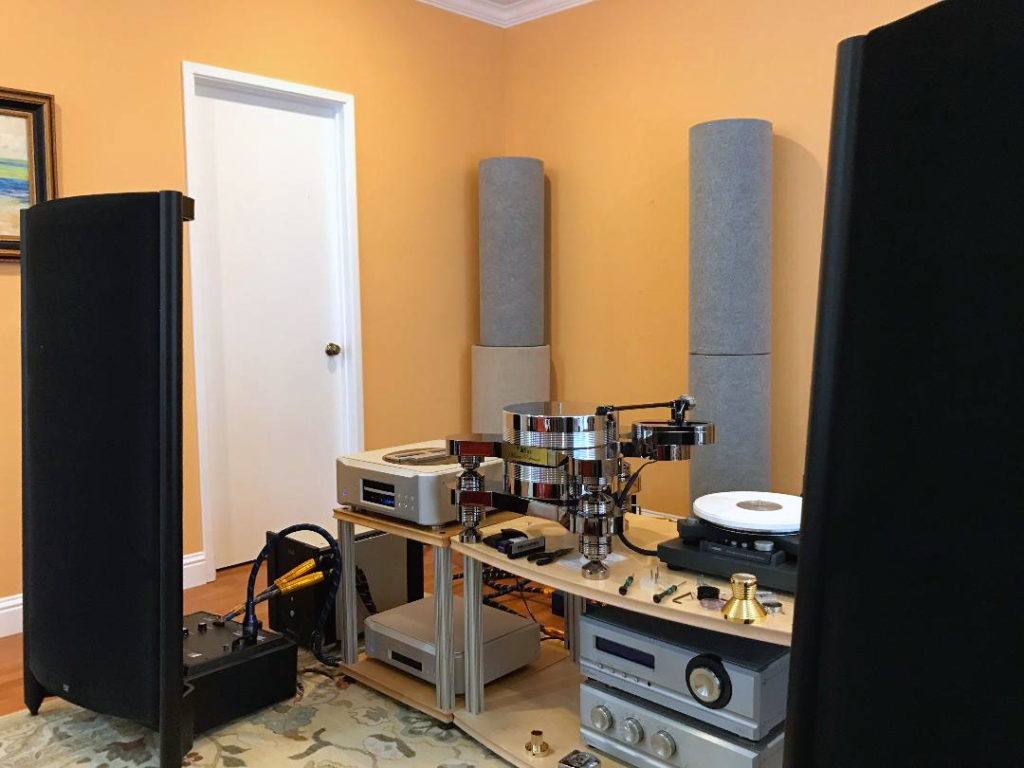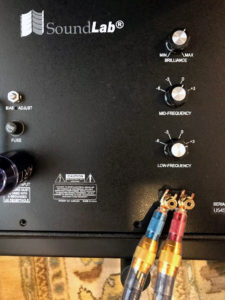Sources for this review included the TriangleArt Master Reference turntable system with the Digital Controller, the Osiris II tonearm, the Apollo moving-coil cartridge, and then the Spiral Groove Revolution turntable system with the Centroid tonearm and the Fuuga cartridge, the Bricasti M1 Limited Edition dual-mono USB DAC, the 47 Laboratory 4741 Izumi CD player/transport, the Esoteric K-01 SACD player/USB DAC and the G-01 Rubidium Clock, the Pass Laboratories Xs Phono for analog playback, the Xs Preamp and the XA-200.8 Class A monoblock amplifiers. Cabling was via the MIT Cables Oracle series, with the Audio Reference Technology Super SE and Analyst power cables providing power to and from two of A.R.T.’s own Distributors. Additionally, the Sound Lab panels required AC charging, and the A.R.T. power cables made non-negotiable improvements over others. The quintessential ASC TubeTraps mitigated room acoustics issues.
At 86dB efficiency with an 8-ohm impedance, the U-545 needed more wattage than current in amplification, so a high-output Class AB would be more appropriate generally. But the XA200.8 is Pass Labs’ most powerful Class A monoblocks in its ‘High Current’ series, occupying only two chassis and second-in-line to the company’s four-chassis, $85k Class A Xs 300, therefore provided the necessary wattages in high-current drive and propelled the panels to enormous scale and performance.
The Sound Lab’s rear module features a BRILLIANCE knob from 7 o’clock to 5 o’clock, a MIDRANGE knob of +3, 0, -3 and -6, and a BASS knob of +3, 0, -3, -6. The bottom-end of the panels are of such prowess at the “0” setting that I just left it there for the initial months. Same for the midrange. The BRILLIANCE setting was left at the 12 o’clock position for the first month, and I found that to be eminently musical and rendered the panels vanishing.
Tonality and separation were supreme with the Sound Lab. At those settings, the Sound Lab Ultimate 545 portrayed the Steinway & Sons piano in Evgeny Kissin’s RCA Victor recording of the Chopin Scherzo #4 in E with complete ease, sounding the most ethereal in transients and spectacular in tone of all speakers I’ve experienced in my listening room. The panels’ realization of the tonal decay of instruments and their delivery of pristine tonality and expeditious, punctual transients were the most startling and impressive among speakers I have had here. I attribute these qualities to a proficient design and the highest implementation of the day’s transducer technologies.
The full-range electrostat’s reiteration of the jazz piano in the First Impression Music K2 HD remastering of jazz vocalist Jacintha’s “Autumn Leaves” made jazz music the most palatable to my ears. It’s recreation of the horn section satiated my craving for the electrostatic trait of an expansive tonal coherence, and presented a sound that resembled the irrepressible speed of the Tannoy Westminster Royal SE’s horn-coupled tweeter/midrange.
The U-545’s prowess in detail resolution on top of instrument separation was of such rarefied order I’ve heard in speakers, that the panel’s 3,125 square inches of planar radiation area projected instruments loud and soft into the listening space meticulously and majestically, in a manner few prestigious multi-driver dynamic speaker systems I’ve heard could approach.
The steel frame of the U-545 supposedly improved the performance of the panel over its 545 Majestic Series and Audiophile Series brethren in their furniture-grade wood frames. Not having the Majestic model also in the house, I couldn’t make direct comparisons, but concise and definitive playbacks of music rich in bottom-end information, such as the JVC XRCD Ondekoza, lent credence to the enhanced rigidity of the steel frame.
These new electrostatics surpassed the Magnepan 3.7i in sonic transparency and piled on unmatched dynamic transients that reproduce instruments with a full-bodied, cunning realism, on top of an earth shattering bottom-end.
The company’s latest innovation, the Bass Focus Technology, adds 6 dB of bass energy to the U-545 over previous generation panels. At the “0” setting of the BASS knob, I found the bottom-end meticulous and well integrated with the rest of the panel, and resisted the temptation of subjecting my fine tuned sensibility to the intoxicating effects of powerful electrostatic bass. The state of mind of audiophiles that befalls single-mindedly to the mind-bending effects of electrostatic bass is well documented. I strive to not lose my objectivity. And I caved.
In the final month of the review, I turned both the BASS and MIDRANGE from the “0” setting to “+3”.
That solid bottom-end performance was epical in projecting the three taiko drums of Ondekoza into my listening space. In the midst of recreating the most compression-free sound that went through it, with this track the completeness and coherency of top-to-bottom spectral extension was simply spectacular. In playing this purely acoustic instrumental piece, the Sound Lab created bottom-end and resolution finesse that breathed vitality into what is a masterpiece.
Tom Bourret, a Sound Lab dealer in the San Francisco Bay Area who owns the $45,000 U-1PX, came over to listen and was awestruck. He is planning to upgrade to one of the new Bass Focus models.
The curved panel technology of Sound Lab offers placement flexibility. I initially positioned the panels 5 feet from the wall behind them, while sitting 12 feet away. At that distance, the sound field created was less focused than I prefer but a slight toe-in snapped the imaging into sharp focus. As months went by, I moved the panels a further 3 feet away from the front wall, prompting the need for a slight increase in toe-in angle. There are instances where a straight firing, no toe-in placement may be warranted. Pass Labs engineer Jam Somasundrum invited me to listen to his X600.8-driven Sound Lab Majestic 2, an older model that is 6 feet tall. In a slightly narrower room than mine, he positioned his gorgeous panels to fire straight ahead, fronting powerful testament to the aptness of even the largest Sound Lab in less spacious spaces.
I had hoped for the dawn of a technology that would lead to the development of midget speakers capable of large scale orchestral reproduction without sacrificing the ability to reenact the gentleness and lightness in Vladimir Horowitz’ playful Moscow live concert recording. But if the sonically and visually tantalizing Sound Lab curved panels are what we have to contend with, I don’t see a problem. For the mere fact that the Sound Lab Ultimate 545 was able to produce tonality of such freshness and clarity that it had cemented its position as the ultimate transducer; never-minding the occasional electrostatic crackling of the panel, a happenstance resulting from a slightly greedy increase of the panel bias, which only added to an already hopelessly fun ownership experience.
The electrostatic technology as implemented to the level and scale of Roger West’s Sound Lab is sophisticated and costly, difficult if not impossible to be copied by others. The performance of these electrostatics is off the charts in my experience. Owning a pair of Sound Lab is not a mere appreciation of the technology and its peerless capabilities, but also shows how serious you are in pursuit of the most realistic music reproduction.
Requiring considerable amplification and yet sonically delicate, pushing dynamic capabilities beyond cone speaker technologies and extending spectral extremes without use of cone woofers, the Ultimate 545 is a definitive expression of one man in his quest for the most natural sounding speaker technology.
Now, I want the Majestic 945. Let’em fill up my room and take my music to the next level.
Copy editor: Dan Rubin
- ← Previous page
- (Page 2 of 2)



Thank you for a very informative review of U545. I heard from someone that a cheaper but larger speaker like M645 may be better than U545. In other words, larger size may be more important than the steel frame for sound clarity. I have a very small room (880 cu ft). Would this principle apply? I would love to hear your thoughts.
Jay,
God’s Peace to you,
I appreciate your enjoyment of the review! You ask an intelligent question in regards to size or construction of the speaker. My understanding is that the stiffer frame resulted in a tightening up of the sound, perhaps a tweaking towards cleaner sound. However, whether that would be considered so significant as to overshadow a much larger model’s sense of grandeur I doubt. I do not think the larger size would get you more “clarity” per se, but rather a bit more bass extension in frequency and larger scale. It would have a sense of a bit less strain or work in reproducing the music. It is very possible that well set up the U545 could be more precise, or have more clarity. So much depends on the actual system set up and cabling.
If I understand the dimensions of your room correctly, it does not seem so small, as it would be at least 20’x40′! That’s a pretty good sized room. In a room such as that, with a ceiling that is high enough (Sound Lab suggests you can size the speaker to just under ceiling height) I would likely go for the larger speaker. You can always use other gear such as cables to tune/clean up the sound, but you cannot duplicate the scale of the speaker’s performance with a smaller model.
Blessings,
Douglas Schroeder
There is no room too small for even our largest speakers, as long as they will physically fit into your room. This may not be the case with point-source speakers, but with the line source speaker, such as ours, it is one of their advantages. Performance-wise, the massive steel framework of the Ultimate series protects and preserves the critical tolerances of the electrostatic panel, eliminates frame vibrations, thus eliminating frame resonance and insuring that all sonic energy is converted to music. Acoustically, however, the Ultimate, Majestic and the Audiophile series are equals. This is because the structural framework of the panel alone is sufficiently rigid and massive to provide full sound quality. Also, the electrostatic panel and the interface electronics of a given series size are identical. In fact, all panel sizes use the same internal construction and interface electronics, thus the only difference among all models is radiating area. Therefore, the 645 series would deliver improved dynamics compared to that of the 545 series, regardless of the styling.
My regards,
Roger West